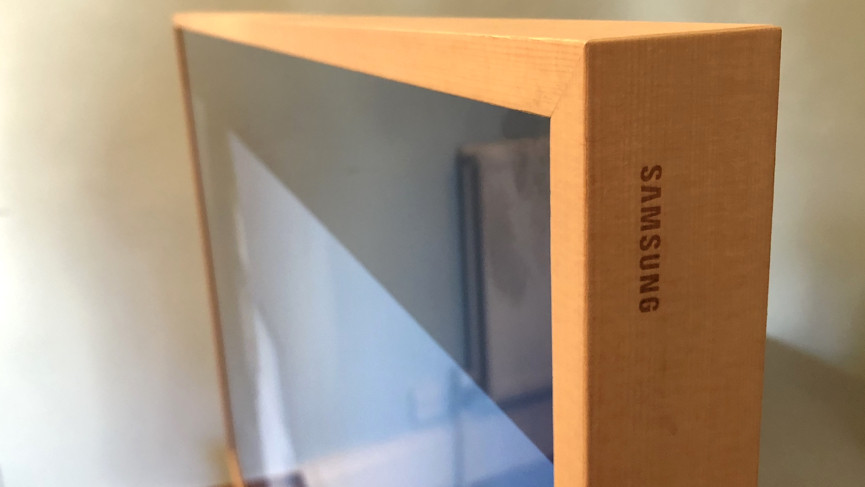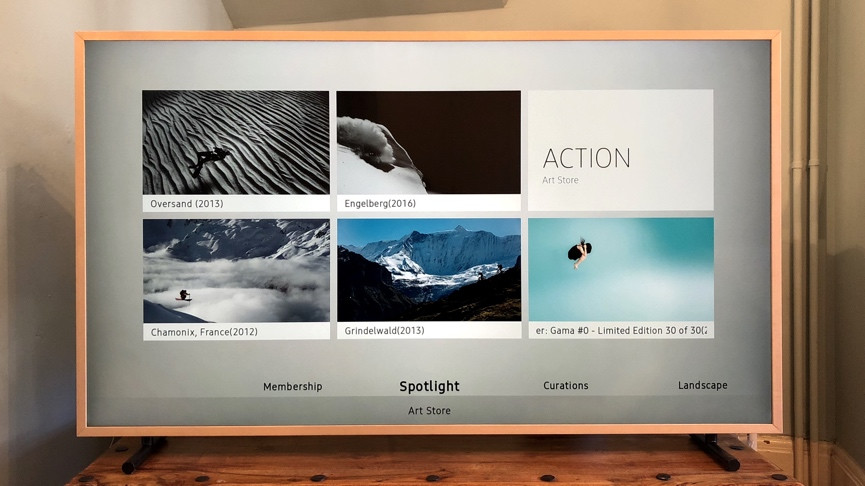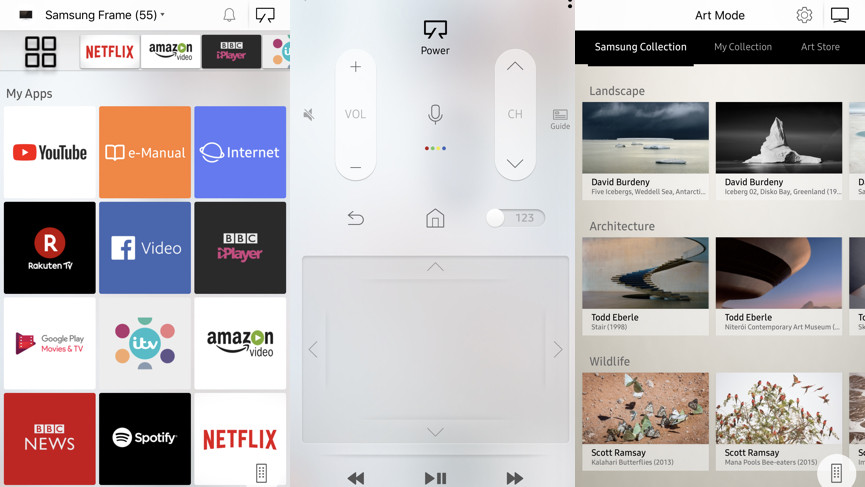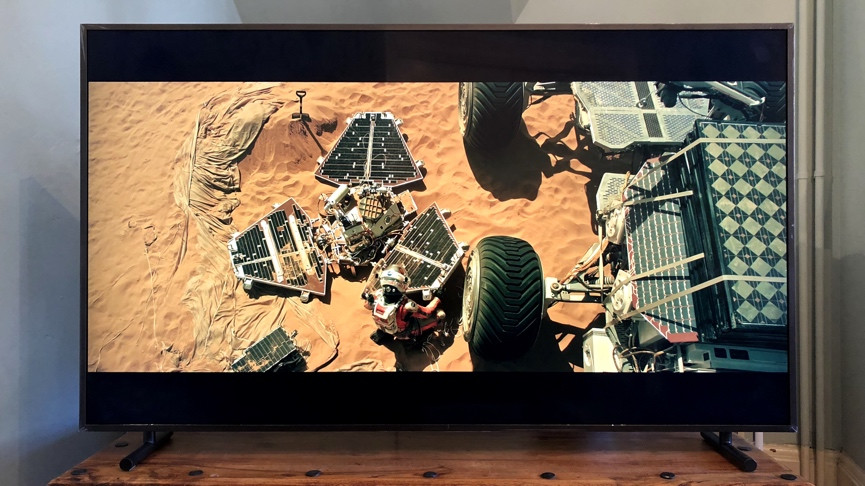When tech and design collide
The TVs we’re buying are getting bigger.
Just a few years ago, the most popular screen size would have hovered around the 40-inch mark. More recently there has been a rise in TVs of 55-inch and above, as prices have gone down and picture quality has gone up.
Thankfully, TV makers seem to have cottoned on to the fact that not all of us want to have our living rooms overtaken by a monolithic slab of glass and plastic. Boring black boxes have now become stylish centrepieces, and arguably none more so than Samsung’s The Frame TV.
Read this: The rise of the design TV
I’ve been living with The Frame to see if it really is the future of TV design and whether the Art Mode is all it’s cracked up to be. It might not be the best smart TV you can get for the money, but as one that doubles as a piece of art when you’re not watching it, it’s certainly one of the most interesting.

Forward thinking design
The Frame TV comes in a choice of 43-inch, 55-inch and 65-inch screen sizes, with the option to have it standalone or wall mounted out of the box.
Considering its forward-thinking design, I found the included slot-in feet rather disappointing in their rather functional form (the flashier easel-like Studio stand you might have seen in promo shots costs around £500 more). They also sit at either end of the screen making it tricky to fit it on to standard TV stands, particularly in the larger screen sizes, like the 55-inch I tested.
Given its name though, it’s fair to assume The Frame is intended to be wall mounted wherever possible, and it comes with Samsung’s two-piece No Gap wall mount to help it really look the part.
It’s simple enough to fit, with the bracket fixed onto the back of the TV, and the mount secured onto the wall, with the help of the included mount guide. From there, the TV does sort of hang like a picture from the mount, and is pulled snug to the wall. The design of the bracket means it can also be tilted forward to improve your viewing angle if mounted higher than the ideal viewing position.

I wasn’t able to do this (due to the joys of inflexible rental agreements), but having seen the Frame wall mounted before, I can say that the extra time doing so is worth it. It sits almost entirely flush to the wall, and comes with a transparent cable that trails inconspicuously from the screen to Samsung’s One Connect box, which houses all the TV’s connections.
The standard bezel is a slim and smart black one, although the TV itself is actually rather chunky in comparison to some of Samsung’s other models. It doesn’t look out of place though, and instead lends itself well to the set’s artsy ambitions.
If you don’t like the black design, there are additional frames you can buy (costing up to £229, depending on screen size) to closer match your decor, which attach to The Frame magnetically. I was sent the light beech finish that simply snapped into place, with a choice of walnut, white, copper or blue aluminium should you prefer.
Art Mode’s subtle shine
The biggest feature of this TV is obviously its Art Mode, which is accessed via an icon in the pop-up home menu, or via the Samsung Smart View app (iOS/Android). Once activated, you can choose from 100 pieces of art, split into themes including still life, wildlife, architecture and landscape, or subscribe to Samsung’s Art Store for £3.99 a month for even more choice.
You can also add your own pictures from your phone or tablet via Smart View and then save them to The Frame for accessing directly at any time, though you’ll want to be sure they’re of a good standard. A lot of my iPhone snaps didn’t look that great when blown up to 55 inches.

Whatever picture you choose (just the one – there’s no slideshow or carousel option here), you can customise the way it appears on screen by choosing whether it has a mount or not, and if it does, what design and colour it should be. There’s a really believable depth to the picture from afar, though up close it is understandably less convincing.
The selection of included art is likely to suffice for most, and I found several pieces I would proudly display in my house, but connoisseurs can browse the Art Store to see if there’s others that they’d prefer.
The Frame comes with an ambient light sensor built into the bottom of the screen that means it will adjust how bright the picture is displayed depending on the light in the room. This is because it wants to look believable as a picture, and avoid shining brightly in a dim room as a TV would.
I found several pieces of digital art I would proudly display in my house
You can manually adjust the brightness in the app though, should you wish, as well as the colour temperature, from warm to cool. However, you won’t get the option to push it as bright as the TV goes in viewing mode in order to keep reflections at a minimum. It’s largely successful, but if it’s placed near a window, you will find it hard not to get any at all.
Is it entirely convincing as a picture rather than a TV? Almost, but not quite. Even with the brightness scaled right down, there’s always a subtle luminance behind it that gave the game away to those on the lookout in my living room. To the uninitiated though, it can be pretty convincing from afar.
On its stand of course, it’s more obvious that it’s a TV, so most of my guests weren’t fooled. But they were impressed at the effect all the same – it solves the problem of having a black rectangle in the room when the TV is off, and at least makes it into something more appealing.
Having your TV on constantly though, even on low brightness, is going to cost you. To help you keep running costs down, The Frame includes a night mode that will turn the TV off when it detects no light (and on again when it does), and a motion detection function, which will switch the TV off after a specified time of no motion in the room. It will then spring back to life once it senses there is, both of which worked pretty accurately for me. Every little helps with those energy bills, eh?

A standard Smart TV setup
The Frame TV uses Samsung’s most recent Tizen smart system found on all of its 2017 TVs, as covered in more depth in our smart TV buying guide.
Aside from the added icon for launching Art Mode, everything here is as standard, which is no bad thing – Samsung’s smart system is one of the best out there. Not only is it clear and easy to navigate, it has a healthy selection of apps too, including Netflix, Amazon, Google Play Movies and TV, Now TV and all the UK’s catch-up services.
However, unlike the QLED set I have, The Frame isn’t picked up as a Thing in the Samsung SmartThings app, which allows you to include your TV as part of a smart home ‘mode’ or routine. It appears that, for now at least, the Smart View app is the only way to control this set from afar, allowing you to access the Art Mode, but also load apps, organise your homepage and access a virtual remote control.
A mid-range picture in a stylish package
In terms of the panel that’s used in the Frame, it’s more on par with a mid-range set than its high-end price tag might suggest. That’s not necessarily a bad thing – Samsung’s MU range is superb – but you’ll just want to be aware that you’re probably paying around double the price of the 55-inch MU8000 (£1079) for the 55-inch The Frame (£1799), for little more in terms of performance.
The first thing to take a hit in any mid-range set is brightness, and that’s noticeable here – particularly as I switched from a QLED display to The Frame. That might work to The Frame’s favour in Art Mode, but means that HDR content does struggle to be as impactful as you’ll find on more accomplished sets. You might also notice black levels suffer a little when playing HDR too, as the backlight is pushed up to its maximum to accommodate it.

Regular 4K content looks great though – as does SD and HD content, which is upscaled really well. Pictures are sharp and detail is plentiful, though you will want to play around in the picture settings to get the best out of it. Out of the box, colours look far too saturated and overblown. I’d recommend opting for Movie mode with a Warm1 colour temperature to get colours as accurate as possible, and then tweak to your taste.
An app like the THX Optimiser will help you here, but for some guidance, I knocked the backlight down to just over halfway, took contrast down a few notches from the maximum and left brightness and sharpness at zero. Colour and tint controls are fine left where they are. You’ll probably want to turn off all of the processing modes too – motion performance is fine without it – and especially ensure HDR+ is switched off. This inflicts a very false-looking HDR effect on SDR content, which, for the most part, just looks oversaturated and odd.
As is the case with most TVs, sound performance isn’t anything to write home about, and is a little thin and harsh, particularly at volume. There’s a lack of depth to the low end too, so action scenes lack body and authority. You’ll probably want to invest in a soundbar to get the best out of it.
Who is The Frame for?
It’s hard not to like what Samsung is trying to do with The Frame TV. While most areas of the tech world worked out how to fit into our home lives more harmoniously some time ago, it’s been a long time coming here.
It’s not perfect – there are HDR and picture niggles that make its price tag seem steep, and it’s worth remembering you will get a comparable picture from the likes of Samsung’s own MU8000 or Sony’s XE85 for around half the price.
However, the people interested in The Frame are unlikely to have budget at the forefront of their concerns. Instead, The Frame will be of interest because of its Art Mode functionality – be that for its aesthetic appeal or for early adopters looking for something different.
Anyone looking for the best picture performance for their money should look elsewhere. But for the design conscious, its unique functionality and avant-garde design will be worth it. If you’ve been looking for a TV that looks like anything but, The Frame is certainly worthy of consideration.





